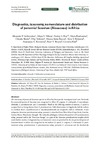Identificador persistente para citar o vincular este elemento:
https://accedacris.ulpgc.es/jspui/handle/10553/41813
| Título: | Diagnostics, taxonomy, nomenclature and distribution of perennial Sesuvium (Aizoaceae) in Africa | Autores/as: | Sukhorukov, Alexander P. Nilova, Maya V. Erst, Andrey S. Kushunina, Maria Baider, Cláudia Verloove, Filip Salas-Pascual, Marcos Belyaeva, Irina V. Krinitsina, Anastasiya A. Bruyns, Peter V. Klak, Cornelia |
Clasificación UNESCO: | 241715 Desarrollo vegetal | Palabras clave: | Africa Aizoaceae Molecular phylogeny New subspecies Sesuvium, et al. |
Fecha de publicación: | 2018 | Publicación seriada: | PhytoKeys | Resumen: | The taxonomy of perennial Sesuvium species in Africa has been poorly investigated until now. Previously five perennial species of Sesuvium were recognised in Africa (S. congense, S. crithmoides, S. mesembryanthemoides, S. portulacastrum, and S. sesuvioides). Based on the differing number of stamens, S. ayresii is accepted here as being distinct from S. portulacastrum. Field observations in Angola also led the authors to conclude that S. crystallinum and S. mesembryanthemoides are conspecific with S. crithmoides. A new subspecies, Sesuvium portulacastrum subsp. persoonii, is described from West Africa (Cape Verde, Gambia, Guinea-Bissau, Mauritania, Senegal). The molecular phylogeny indicates the position of S. portulacastrum subsp. persoonii within the "American lineage" as a part of the Sesuvium portulacastrum complex which needs further studies. A diagnostic key and taxonomic notes are provided for the six perennial species of Sesuvium found in Africa and recognised by the authors (S. ayresii, S. congense, S. crithmoides, S. portulacastrum subsp. portulacastrum, S. portulacastrum subsp. persoonii, S. verrucosum and the facultatively short-lived S. sesuvioides). The distribution of S. crithmoides, previously considered to be endemic to Angola, is now confirmed for the seashores of Republic of Congo and DR Congo. The American species S. verrucosum is reported for the first time for Africa (the Macaronesian islands: Cape Verde and the Canaries). It is locally naturalised in Gran Canaria, being a potentially invasive species. These findings as well as new records of S. verrucosum from Asia and the Pacific Islands confirm its proneness to transcontinental introduction. Lectotypes of S. brevifolium, S. crithmoides, S. crystallinum and S. mesembryanthemoides are selected. The seed micromorphology and anatomy of the perennial African species is studied. Compared to the seeds of some annual African Sesuvium investigated earlier, those of perennial species are smooth or slightly alveolate. The aril is one-layered and parenchymatous in all species and usually tightly covers the seed. The aril detachments from the seed coat that form a white stripe near the cotyledon area easily distinguish S. verrucosum from other species under study. | URI: | https://accedacris.ulpgc.es/handle/10553/41813 | ISSN: | 1314-2011 | DOI: | 10.3897/phytokeys.92.22205 | Fuente: | Phytokeys[ISSN 1314-2011] (92), p. 45-88 |
| Colección: | Artículos |
Citas SCOPUSTM
15
actualizado el 08-jun-2025
Citas de WEB OF SCIENCETM
Citations
15
actualizado el 08-jun-2025
Visitas
134
actualizado el 27-sep-2025
Descargas
157
actualizado el 27-sep-2025
Google ScholarTM
Verifica
Altmetric
Comparte
Exporta metadatos
Los elementos en ULPGC accedaCRIS están protegidos por derechos de autor con todos los derechos reservados, a menos que se indique lo contrario.
